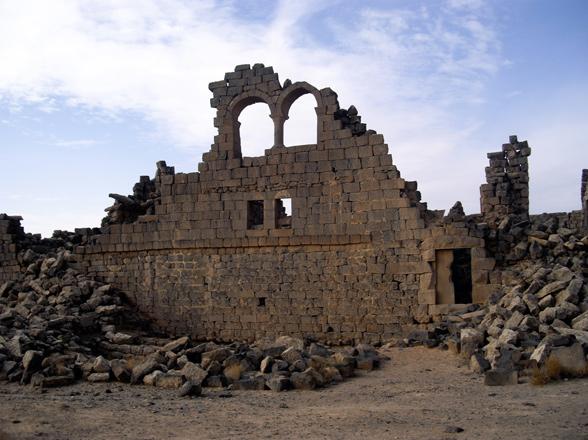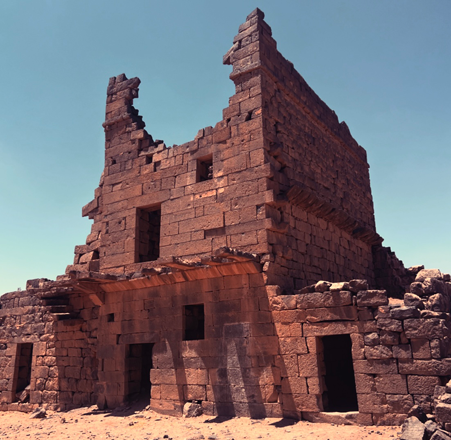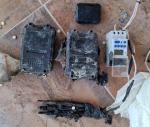You are here
Scholar explores past of Um Al Jimal through ceramics study
By Saeb Rawashdeh - Feb 22,2018 - Last updated at Feb 25,2018

House XVIII at the site of Um Al Jimal, some 70km northeast of Amman (Photo courtesy of Um Al Jimal Project)
AMMAN — The lack of coins at Um Al Jimal, located 70 km northeast of Amman, forced researchers to rely on ceramics as the primary tool used dating the site, according to Elizabeth Osinga, who received a PhD in archaeology from the University of Southampton.
Prior to 2012, pottery was not recorded using strict methodology, she recalled, noting that her “study of the ceramics was the first in northeastern Jordan to employ quantification by ware/fabric and pottery type, and to attempt to source the pottery [including the use of petrology]”.
By building a typo-chronology based on regional parallels, she was able to determine how long certain wares were in use and where they came from.
Osinga noted that the pattern that emerged indicated that pottery manufactured in the Hauran (southwestern Syria and northwestern Jordan) was common in the Nabataean and Roman periods, but seems to have started declining in the 4th century AD.
“Other pottery was produced at Jerash and other unknown sites, and it was also present in these early periods, but by the 6th century AD, Jerash was the major supplier,” the ceramicist emphasised.
Another important discovery was the presence of the Middle Islamic ceramics, some of which had been mistakenly ascribed to the Late Ottoman period in the past, she underlined.
The focus of researchers was put on House XVII and House XVIII at the Um Al Jimal site, Osinga noted, adding “even though the complex was built in the early 6th century AD, there was stratigraphy [the analysis of the order and position of layers of archaeological remains] from earlier periods above bedrock in some places.”
The research team also found hints that there may have been a structure(s) in the area of the houses, but no occupation deposits, wall lines, or foundations.
During the Umayyad reconstruction, the scholar said, any previous layers were disturbed, and in House XVII, occupation debris was simply cleaned off the flagstone floors.
“With this sort of stratigraphy, the ceramics were therefore typically jumbled together: under the Umayyad surfaces in House XVIII’s courtyard, it was common to find a mixture of Nabataean/Roman through Umayyad pottery, “ she explained.
Nonetheless, the ceramics beneath the original floors in House XVII and the later Umayyad ones were essential in determining the dates of their construction, Osinga countinued.
Pottery was very important at House XVII-XVIII and it was thanks to the ceramic evidence that the team of researchers was able to date its construction and remodeling.
Furthermore, the most striking transformation was the removal of the original surface in House XVIII’s courtyard (probably plaster and mosaic) during the Umayyad period and its replacement with well-cut flagstones around the edges, and in one part with a thinly laid plaster floor, which still yields traces of red paint.
“It was also at this time that the south gate was built, creating a monumental-type entrance into the fine courtyard. What the archaeology cannot tell us, of course, is whether these changes indicate a new function —a caravanserai or an administrative building, perhaps? — or whether a wealthy landowner is simply showing off for the town,” Osingspeculated.
Regarding future plans, Osinga is currently involved with several ongoing projects at Um Al Jimal, such as designing a pottery exhibit for the Interpretive Centre at the site, and reexamining ceramics and stratigraphy from previous excavations at some of the churches and the early 4th century castellum.
“While we’ve made great strides in understanding Um Al Jimal’s pottery over the past few years, there is much more work to be done, such as: tracing social and economic connections with other sites in the region over time, and understanding the patterns of ceramic use, reuse and deposition at Um Al Jimal itself, and how these relate to the social, agricultural and other activities at the town,” Osinga concluded.
Related Articles
AMMAN — US Ambassador to Jordan Alice G.
Umm Al Jimal/Mafraq — Following the inscription of Umm Al Jimal on the UNESCO World Heritage List, Jordan is working on registering other si
AMMAN — The United Nations Educational, Scientific and Cultural Organisation (UNESCO) has announced the inclusion of Umm Jimal to the UNESCO

















